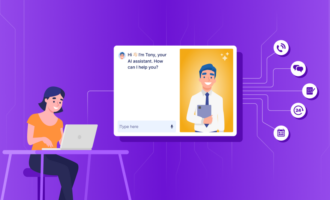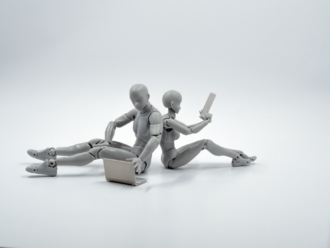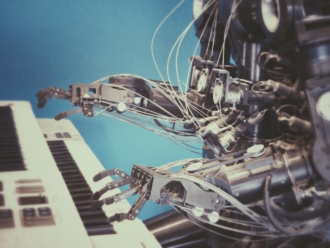Multi-agent AI is a field of artificial intelligence in which multiple “agents” (independent, intelligent software or robots) collaborate to tackle tasks or problems. Instead of a single, giant AI that tries to do everything, multi-agent AI breaks down the job among different agents, each with specific skills or viewpoints. Think of it as a team of specialists rather than an overworked jack-of-all-trades.
Traditional AI often revolved around one model doing all the heavy lifting, like playing an entire chess game alone. However, as projects became larger and more complex, researchers realized they needed a more distributed, team-based approach. Now, whether it’s coordinating delivery drones or managing real-time traffic signals, multi-agent AI has proven it can handle more significant challenges more efficiently.
In our interconnected, data-driven world, problems like optimizing supply chains, managing energy grids, or controlling fleets of self-driving vehicles often involve numerous moving parts and decision-makers.
Multi-agent AI perfectly mirrors the real world, with multiple entities cooperating (and sometimes competing) to find a shared solution.
Key components of multi-agent systems
To understand why multi-agent AI is so powerful, let’s look at its main building blocks.
Agents
These are the “workers” in the system. Each agent
- Operates on its own (autonomous)
- Reacts to the environment (reactive)
- Has goals or objectives (proactive)
- Interacts with other agents (social)
An agent might be a drone delivering packages or software scanning the stock market. The system can tackle problems from different perspectives by having many specialized agents.
Environment
The environment is the world in which agents function — physical places like warehouses or roads or virtual settings like online marketplaces. A complex environment requires agents to be more adaptive, sometimes forcing them to see only part of the bigger picture. This partial view means they need to communicate and collaborate to complete the puzzle.
Communication
Agents share information through direct messages (like sending signals to one another) or indirectly (updating a shared database or even leaving digital “notes” in their environment). Good communication protocols ensure that agents coordinate smoothly rather than tripping over each other.
Coordination and collaboration
Imagine multiple chefs in a busy kitchen. Each cook has a role, but they still communicate to avoid chaos and to make sure all dishes come out perfectly. In multi-agent AI, coordination might involve
- Task allocation: Dividing tasks among agents
- Negotiation: Working out conflicts or competing interests
- Consensus-building: Agreeing on shared decisions
When agents successfully collaborate, they can solve more significant, more complex challenges than any single agent (or chef) could handle alone.
Benefits of multi-agent AI
Why go through the trouble of building multi-agent systems? Here are the standout perks.
Scalability and flexibility
Because each agent is like a self-contained module, you can easily add new agents when you need them — or remove them when you don’t. If you suddenly need to handle more delivery routes, you can simply spin up more agents without overhauling your entire AI system.
Collaborative problem-solving
Multiple agents can combine their unique perspectives, leading to more creative and efficient solutions. This is especially handy when data is scattered — agents handle local computations and then share results, cutting down on unnecessary back-and-forth.
Real-time adaptability
In fast-moving scenarios like self-driving cars or financial trading, each agent can respond immediately to local changes while still cooperating with others. This cuts delays and helps the system stay flexible and responsive.
Reduced computational overhead
Instead of one mega-computer doing everything, multi-agent AI spreads out the work. This can lower computing costs and boost reliability. If one agent fails, others can keep things running, making the entire system more tolerant of faults.
Specialization and expertise
Multi-agent AI allows each agent to specialize in a specific task or domain, becoming an expert in its niche. This specialization enhances overall performance, as agents are optimized for their roles, whether analyzing weather patterns, managing logistics, or optimizing energy usage. When these specialized agents work together, they create a highly efficient system that leverages the strengths of each component, resulting in better outcomes for complex, multifaceted problems.
Real-world applications of multi-agent systems
Let’s explore some real-world scenarios where multi-agent AI is already making a difference.
Robotics and autonomous vehicles
From coordinating drone deliveries to managing a city’s fleet of self-driving cars, multi-agent AI helps each vehicle handle its own tasks (steering, avoiding collisions) while also working with others to optimize overall traffic flow. This teamwork is what enables safer roads, faster deliveries, and fewer traffic jams.
Supply chain and logistics optimization
Supply chains involve many moving pieces — warehouses, trucks, and even shipping containers. In a multi-agent system, each piece can be tracked and managed by its own intelligent agent. They collectively decide how to reroute shipments if a warehouse runs low on stock or if there’s a traffic bottleneck on a major highway.
Smart grids and energy distribution
Modern power grids draw energy from multiple sources — like solar, wind, and traditional plants — and deliver electricity to countless homes and businesses. Multi-agent AI allows each part of the grid to manage local supply and demand, balancing the system and reducing waste. Agents can even shift energy usage to off-peak times, saving money and boosting reliability.
Healthcare and diagnostics
In healthcare, multi-agent AI can assist with patient monitoring, resource allocation, and speedy diagnosis. Imagine having one agent continuously track a patient’s vitals while another agent flags patterns and alerts the right specialist. During crises (think pandemic response), this collaboration becomes invaluable for managing large-scale interventions like vaccine distribution or hospital bed allocation.
Finance and stock market analysis
Financial markets are always changing and involve countless transactions at lightning speed — perfect conditions for a multi-agent system. Different trading bots analyze various market segments, share signals, and make rapid investment decisions. This approach spreads risk and can help detect fraudulent behavior as multiple agents compare notes to spot transaction anomalies.
Challenges and limitations of multi-agent AI
Multi-agent AI offers many advantages, but it’s not a silver bullet. Here are a few hurdles.
Technical complexity in system design
Building a multi-agent system is more involved than designing a single AI model. Engineers have to figure out how agents communicate, how tasks are split up, and how to avoid stepping on each other’s toes. This requires a good amount of planning and sometimes deep domain expertise.
Communication overhead
While communication is crucial, it can also become a data bottleneck. If agents constantly flood each other with messages, the network can slow to a crawl. Designers often have to balance rich communication (for accuracy) and limiting message volume (for efficiency).
Conflict resolution
Conflicts are bound to happen in a shared environment. Two self-driving taxis might aim for the same pickup spot at the same time, or different supply chain agents might fight over the same truck route. Resolving these disputes through negotiation or auction-based methods adds an extra layer of complexity.
Scalability in highly dynamic environments
Multi-agent systems can be very scalable, but keeping everyone coordinated can be tricky if the environment changes too fast (say, in a highly volatile market or a chaotic traffic scenario). Rapid changes can lead to partial system failures or a cascade of errors if not managed carefully.
Security and trust issues
In multi-agent systems, ensuring that all agents behave as intended and are not compromised poses a significant challenge. If one agent is hacked or behaves maliciously, it can disrupt the entire system or even manipulate outcomes. Establishing trust between agents, especially in open or decentralized environments, requires robust security protocols, authentication tools, and mechanisms to detect and isolate malicious behavior, which adds to the system’s complexity.
The future of multi-agent AI
The road ahead for multi-agent AI looks bright, with several exciting trends taking shape.
Integration with advanced machine learning
Many current multi-agent systems use simpler, rule-based decision-making approaches. As deep learning and other advanced methods evolve, they will increasingly integrate into multi-agent architectures — meaning agents will learn from experience and continually improve their cooperation.
Decentralized applications and blockchain
Blockchain technology makes it possible to coordinate multiple parties without relying on a single controlling authority. Pairing multi-agent AI with blockchain could completely change how organizations handle contracts, resources, or financial transactions. Picture agents autonomously negotiating and executing “smart contracts” on a blockchain, all while staying secure and transparent.
Enhanced human-AI collaboration
It’s not just about machines working with machines — humans can join the collaboration too. Imagine giving natural-language instructions to a team of AI agents that can instantly divide the work. This setup paves the way for hybrid teams where AI handles tedious or data-heavy tasks and humans focus on creativity and strategy.
Final thoughts
Multi-agent AI is all about teamwork — breaking down complex challenges into pieces that can be handled by specialized, cooperative agents. This approach shines in fields as diverse as logistics, finance, healthcare, and robotics, especially in today’s interconnected landscape.
While issues like communication overhead and conflict resolution still pose hurdles, research is continually refining how these systems interact and learn. With deeper machine learning integration and the rise of decentralized technologies like blockchain, multi-agent AI is well on its way to reshaping how we design, build, and benefit from future AI solutions.
Simply put, if you’re facing a large-scale, complex problem, there’s a good chance that multi-agent AI might hold the keys to a more efficient, scalable, and innovative solution.


















































Send Comment: